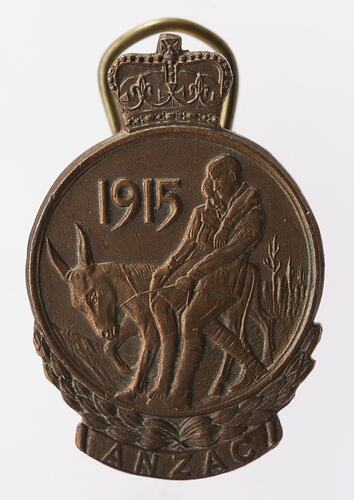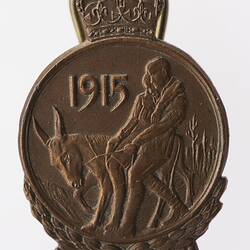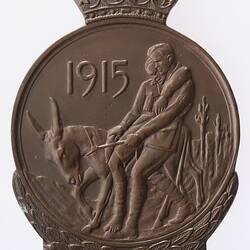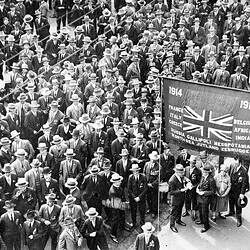Summary
Anzac commemorative badge awarded to Col. J. Rex Hall, O.B.E.
Joseph Rex Hall was a 19 year old accountant when he enlisted on 18 August 1914 (just two weeks after war was declared by Britain). He had already served for 2 1/2 years in the military forces (28th Australian Army Medical Corps). His service number was 63, reflecting the early date of his enlistment. He served in the Light Horse and Camel Corps in the Middle East (with a period in Gallipoli), escaping injury although experiencing illness. He returned to Australia in July 1919.
Hall's involvement with the military continued, and in May 1921 he was a candidate for a commission in the 2nd Cavalry Division. He served again in World War II, enlisting 6 August 1942 at East Malvern (service number VX80978 (V24238)). He was discharged on 13 December 1946 at the rank of Lieutenant Colonel in the 23/21 Australian Infantry Battalion.
In March 1967 the Prime Minister, the Rt. Hon. Harold Holt, announced that a commemorative medallion and badge was to be issued to surviving members of the Australian Defence Force who served on the Gallipoli Peninsula, or in direct support of the operations from close off shore, at any time during the period from the first ANZAC Day in April 1915 to the date of final evacuation in January 1916.
Physical Description
A circular bronze centre with crown at top and wreath and plaque at base. The obverse features Simpson and his donkey carrying a wounded soldier to safety; in the field above, 1915; the wreath below is laurel and the plaque carries the word, ANZAC. The reverse has a lapel badge attachment and is engraved J.R. HALL.
Obverse Description
Bronze with crown at top and wreath and plaque at base. At centre, Simpson and his donkey carrying a wounded soldier to safety; in the field above, '1915'; the wreath below is laurel and the plaque carries the word, 'ANZAC'.
Reverse Description
'J.R. HALL'
Significance
A commemorative medallion and badge was to be issued to surviving members of the Australian Defence Force who served on the Gallipoli Peninsula, or in direct support of the operations from close off shore, at any time during the period from the first ANZAC Day in April 1915 to the date of final evacuation in January 1916. The medal could be claimed by surviving family but the badge could only be claimed by a person who served in the Gallipoli campaign.
More Information
-
Collection Names
-
Collecting Areas
-
Acquisition Information
Donation from Victorian Branch, Returned & Services League of Australia Limited (RSL), 24 Feb 1986
-
Date Issued
1967 AD
-
Issued By
-
Artist
-
Designer
-
Awarded To
-
Place
Gallipoli Peninsula, Turkey
Place commemorated: a commemorative medallion and badge was to be issued to surviving members of the Australian Defence Force who served on the Gallipoli Peninsula, or in direct support of the operations from close off shore. -
Inscriptions
Obverse: J.R. HALL Reverse: ANZAC 1915
-
Material
Bronze
-
Classification
-
Category
-
Discipline
-
Type of item
-
Overall Dimensions
22 mm (Width), 10 mm (Depth), 34 mm (Height)
-
Shape
Round with crown at top
-
References
National Archives series B2455/1, barcode 3007726, Hall Joseph Rex. World War II Nominal Roll [Link 1] accessed 8/1/2010. Information on corps and brigades in which Hall served from Australian War Memorial website, accessed 8/1/2010.
-
Keywords
Anzac Day, Commemorations, Wars & Conflicts, World War I, 1914-1918




